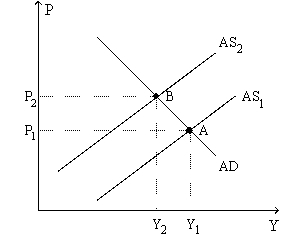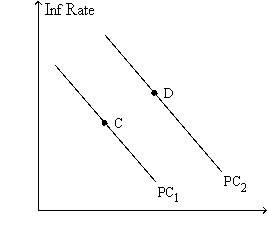A) unemployment and inflation are higher.
B) unemployment and inflation are lower.
C) unemployment is higher and inflation is lower.
D) unemployment is lower and inflation is higher.
F) B) and C)
Correct Answer

verified
Correct Answer
verified
Multiple Choice
In the long run, an increase in the money supply growth rate
A) increases inflation and shifts the short-run Phillips curve right.
B) increases inflation and shifts the short-run Phillips curve left.
C) decreases inflation and shifts the short-run Philips curve right.
D) decreases inflation and shifts the short-run Phillips curve left.
F) A) and D)
Correct Answer

verified
Correct Answer
verified
Multiple Choice
When monetary and fiscal policymakers expand aggregate demand, which of the following costs is incurred in the short run?
A) Short-run aggregate supply decreases.
B) The natural rate of unemployment increases.
C) The price level increases more rapidly.
D) The money supply increases less rapidly.
F) A) and B)
Correct Answer

verified
Correct Answer
verified
Multiple Choice
Figure 35-9. The left-hand graph shows a short-run aggregate-supply (SRAS) curve and two aggregate-demand (AD) curves. On the right-hand diagram, "Inf Rate" means "Inflation Rate." 
 -Refer to Figure 35-9. Faced with the shift of the Phillips curve from PC1 to PC2, policymakers will
-Refer to Figure 35-9. Faced with the shift of the Phillips curve from PC1 to PC2, policymakers will
A) ask whether the shift is temporary or permanent.
B) be concerned with how people adjust their expectations of inflation as a result of the shift.
C) face, as well, a decision as to whether to accommodate the shock.
D) All of the above are correct.
F) B) and D)
Correct Answer

verified
Correct Answer
verified
Multiple Choice
According to Friedman and Phelps, the unemployment rate
A) is never below its natural rate.
B) is below its natural rate when actual inflation is greater than expected inflation.
C) is below its natural rate when actual inflation is less than expected inflation.
D) is below its natural rate when actual inflation equals expected inflation.
F) A) and C)
Correct Answer

verified
Correct Answer
verified
Multiple Choice
Friedman argued that the Fed could use monetary policy to peg
A) nominal exchange rates.
B) the level of real GDP.
C) the rate of unemployment.
D) None of the above is correct.
F) All of the above
Correct Answer

verified
Correct Answer
verified
Multiple Choice
The very low inflation that the U.S. experienced in 2009 and 2010
A) appears to have reduced expected inflation, and the short-run Phillips curve shifted downward as a result.
B) appears to have reduced expected inflation, and the short-run Phillips curve shifted upward as a result.
C) does not appear to have reduced expected inflation, and the short-run Phillips curve remained relatively stable as a result.
D) does not appear to have reduced expected inflation, but the short-run Phillips curve shifted dramatically nevertheless.
F) All of the above
Correct Answer

verified
Correct Answer
verified
Multiple Choice
If a central bank wants to counter the change in the price level caused by an adverse supply shock, it could change the money supply to shift
A) aggregate demand right.
B) aggregate demand left.
C) aggregate supply right.
D) aggregate supply left.
F) A) and C)
Correct Answer

verified
Correct Answer
verified
True/False
The analysis of Friedman and Phelps argues that an expected change in inflation has no impact on the unemployment rate.
B) False
Correct Answer

verified
Correct Answer
verified
Multiple Choice
An adverse supply shock will cause output
A) and prices to rise.
B) and prices to fall.
C) to rise and prices to fall.
D) to fall and prices to rise.
F) All of the above
Correct Answer

verified
Correct Answer
verified
Multiple Choice
If the long-run Phillips curve shifts to the left, then for any given rate of money growth and inflation the economy has
A) higher unemployment and lower output.
B) higher unemployment and higher output.
C) lower unemployment and lower output.
D) lower unemployment and higher output.
F) A) and C)
Correct Answer

verified
Correct Answer
verified
Multiple Choice
In the long run, an increase in the money supply growth rate
A) shifts both the long-run and the short-run Phillips curves right.
B) shifts the long-run Phillips curve left and the short-run Phillips curve right.
C) shifts the long-run Phillips curve right and the short-run Phillips curve left.
D) None of the above is correct.
F) B) and C)
Correct Answer

verified
Correct Answer
verified
Multiple Choice
When they are confronted with an adverse shock to aggregate supply, policymakers face a difficult choice in that
A) if they contract aggregate demand, the unemployment rate will increase further.
B) if they expand aggregate demand, the inflation rate will increase further.
C) they face a less favorable trade-off between inflation and unemployment than they did before the shock.
D) All of the above are correct.
F) B) and D)
Correct Answer

verified
Correct Answer
verified
Multiple Choice
If the Federal Reserve increases the growth rate of the money supply, in the long run
A) inflation is higher and the unemployment rate is lower.
B) inflation is higher while the unemployment rate is unchanged.
C) inflation is unchanged while the unemployment rate is lower.
D) None of the above is correct.
F) B) and C)
Correct Answer

verified
Correct Answer
verified
Multiple Choice
Any policy change that reduced the natural rate of unemployment
A) would shift the long-run Phillips curve to the right.
B) would shift the long-run aggregate-supply curve to the right.
C) would be a policy change that impeded the functioning of the labor market.
D) All of the above are correct.
F) A) and D)
Correct Answer

verified
Correct Answer
verified
Multiple Choice
In the equation, Unemployment rate = Natural rate of unemployment - a × (Αctual inflation - Expected inflation) , the variable a is a parameter that measures how much
A) actual inflation responds to expected inflation.
B) expected inflation responds to actual inflation.
C) the natural rate of unemployment responds to unexpected inflation.
D) actual unemployment responds to unexpected inflation.
F) A) and D)
Correct Answer

verified
Correct Answer
verified
Multiple Choice
If a central bank increases the money supply in response to an adverse supply shock, then which of the following quantities moves closer to its pre-shock value as a result?
A) both the price level and output
B) the price level but not output
C) output but not the price level
D) neither output nor the price level
F) B) and D)
Correct Answer

verified
Correct Answer
verified
Multiple Choice
Which of the following played a role in depressing aggregate demand in 2001?
A) the end of a stock-market bubble
B) corporate accounting scandals
C) the terrorist attacks on September 11 of that year
D) All of the above are correct.
F) B) and D)
Correct Answer

verified
Correct Answer
verified
Multiple Choice
If the Federal Reserve increases the rate at which it increases the money supply, then unemployment is lower
A) in the long run and the short run.
B) in the long run but not the short run.
C) in the short run but not the long run.
D) in neither the short run nor the long run.
F) B) and C)
Correct Answer

verified
Correct Answer
verified
Multiple Choice
The short-run relationship between inflation and unemployment is often called
A) the Classical Dichotomy.
B) Money Neutrality.
C) the Phillips curve.
D) None of the above is correct.
F) C) and D)
Correct Answer

verified
Correct Answer
verified
Showing 441 - 460 of 491
Related Exams